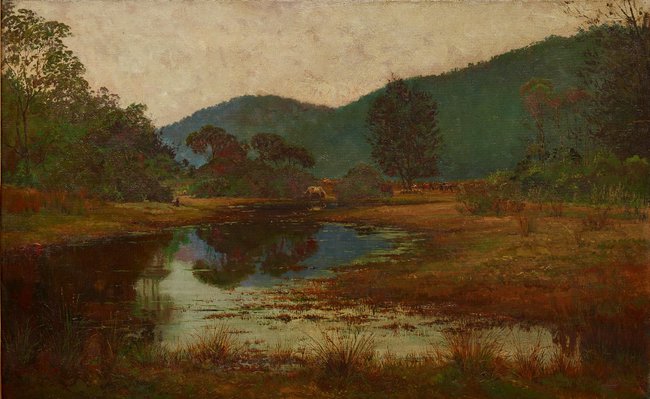Art Sets.
Fieldwork
Print this setBy the Art Gallery of NSW
The wild west
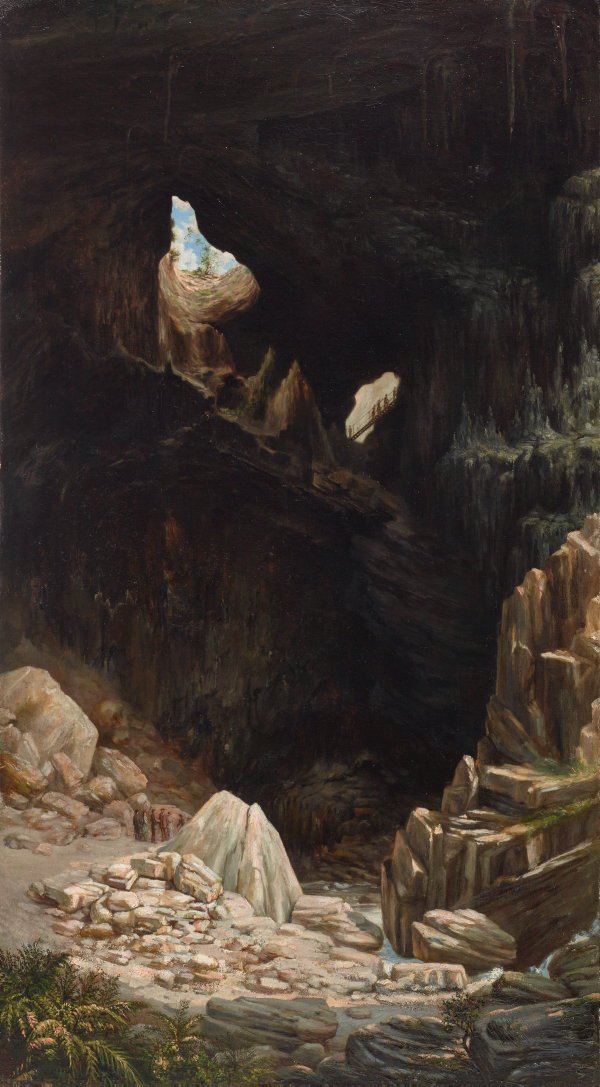
AGNSW collection Lucien Henry Devil's Coach-house, Fish River Caves 1883
Lucien Henry was a French-Australian artist who arrived in Sydney from New Caledonia in 1879. Henry had trained under architect Eugene- Emmanuel Viollet-le-Duc and painter Jean-Léon Gérôme at the École des Beaux-Art in Paris, but was imprisoned and exiled to New Caledonia for his participation in the Paris Commune in 1871. In Sydney, Henry became an influential teacher and artist in the 1880s and early 1890s. He is also remembered for his pioneering use of Australian flora and fauna in fine and decorative arts.
Henry’s Devil’s Coach-House, Fish River Caves is an otherworldly depiction of Jenolan Caves, formerly known as Fish River Caves, or Binomil/Binoomur to the Burra Burra of Gundungurra Country. The vast and shadowy entrance to the cave, known as the Devil’s Coach House, is partially illuminated by sunlight billowing down from a cavity in the ceiling. Upon closer inspection we can spot a procession of hikers ascending a flight of stairs in one of the cave’s many chambers, and another group of people assembled at the foot of the arch.
The Hawkesbury and Australian impressionism
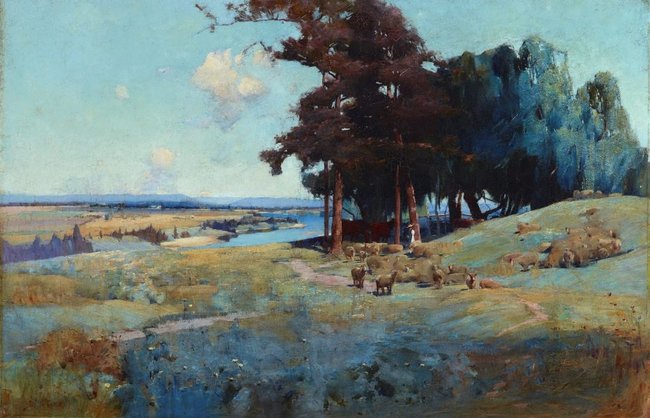
AGNSW collection Sydney Long Midday 1896
A languid afternoon atmosphere is conjured by Sydney Long in this timeless landscape. Here, Long has painted a shepherdess tending to her flock of sheep on the fertile banks of the Hawkesbury River in an idyllic scene composed of soft, pale blues and greens.
Long was a protégé of plein-air artists and teachers Julian Ashton and AJ Daplyn in the Art Society of NSW. He painted plein air and also incorporated symbolist and art nouveau motifs into his highly original landscapes of the mid 1890s and 1910s. Although the scenery depicted in Long’s painting is characteristically Australian, the impression he seeks to convey is one of an idealised pastoral Arcadia.
Long revisited the Hawkesbury River region shortly after he returned to Australia from England in 1925, painting at St Albans and the McDonald River.
Landscapes of yesteryear
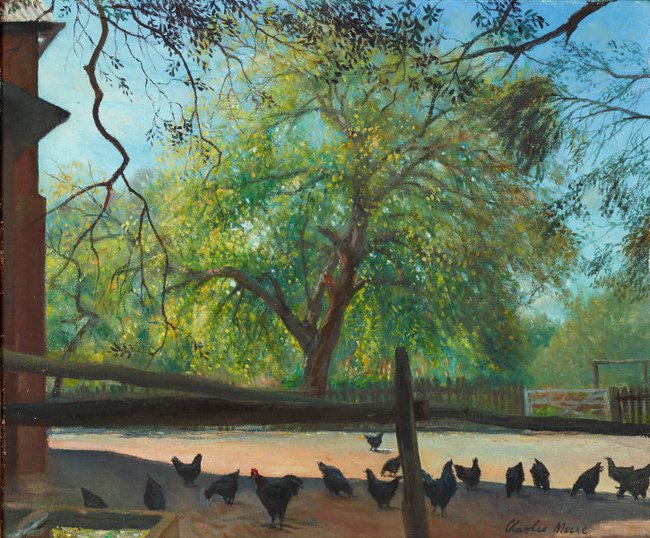
AGNSW collection Charles Meere The old coach house yard, Brownlow Hill 1953
A colonial village of national significance outside of Campbelltown on Dharawal Country seems like an unusual choice of subject for Charles Meere, who is typically associated with neo-classical figurative painting. It seems likely that Meere painted Brownlow Hill because it spoke to the nationalist sentiment of the early 1950s. Indeed, in 1951 Meere was one of seven artists invited by Prime Minister Robert Menzies to paint a historical subject for an art prize celebrating the Australian Silver Jubilee that year. Meere was also gaining recognition for his landscape painting in the early 1950s, winning the Wynne Prize for landscape painting in 1951 with his work Never-Never Creek, Gleniffer.
Western Sydney moderns
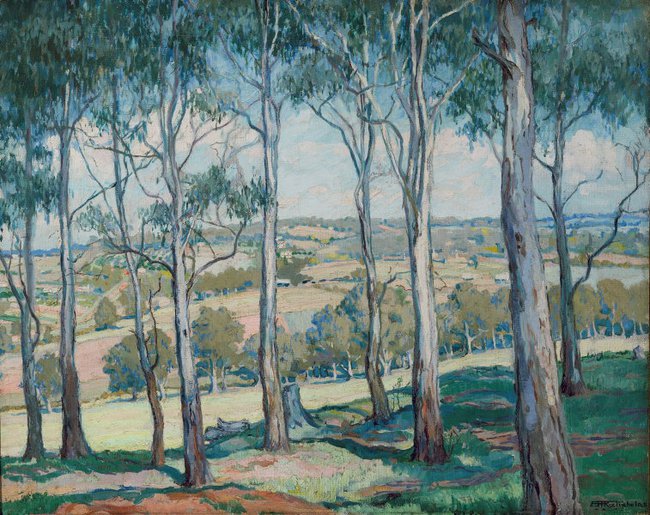
AGNSW collection Hilda Rix Nicholas Through the gum trees, Toongabbie circa 1920
This work was painted shortly after expatriate artist Hilda Rix Nicholas had resettled in Australia in 1918. Rix Nicholas lived and worked in France and Morocco between 1907 and 1918 and had tragically lost her soldier husband while he was fighting on the Western Front during the First World War. Back in Australia, Rix Nicholas channelled her grief and post-war patriotism into plein-air painting, travelling west to Toongabbie on Darug Country in search of regional motifs to depict. It was uncommon for a woman artist at the time to tackle such traditionally masculine and nationalistic motifs, however Rix Nicholas was undeterred, famously declaring herself ‘the man for the job’.
In Through the gum trees, Toongabbie, Rix Nicholas has painted an undulating hillside punctuated by tall gumtrees and a patterned canopy of leaves. Its decorative elements and saturated colour are indebted to Rix Nicholas’s encounters with impressionism and post-impressionism in France.
Elioth Gruner at Emu Plains 1915–19
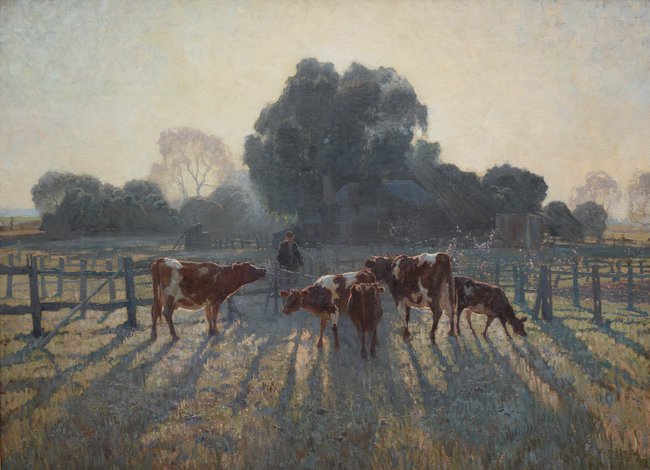
AGNSW collection Elioth Gruner Spring frost 1919
Spring frost represents the high-point of Elioth Gruner’s Emu Plains series of works and is arguably his crowning artistic achievement. Here, Gruner’s bucolic landscape enveloped in bright light conveys an intensely lyrical and evocative scene of rural contentment and plenitude.
Gruner painted Spring frost one cold spring morning, famously building a makeshift shelter to protect the canvas from the elements and wrapping his feet in chaff bags to prevent frostbite. He composed the scene looking east, setting the shadowy mass of the farmhouse and its surrounding peppercorn trees against the intense light beaming out from the dawning sun. Long purple shadows are cast across the grass in the foreground by the fence and the farmer’s livestock.
Due to its large size, Gruner probably completed Spring frost back in the studio. It was awarded the Wynne Prize for landscape painting in 1919 and is arguably the Art Gallery of NSW’s most loved Australian painting.
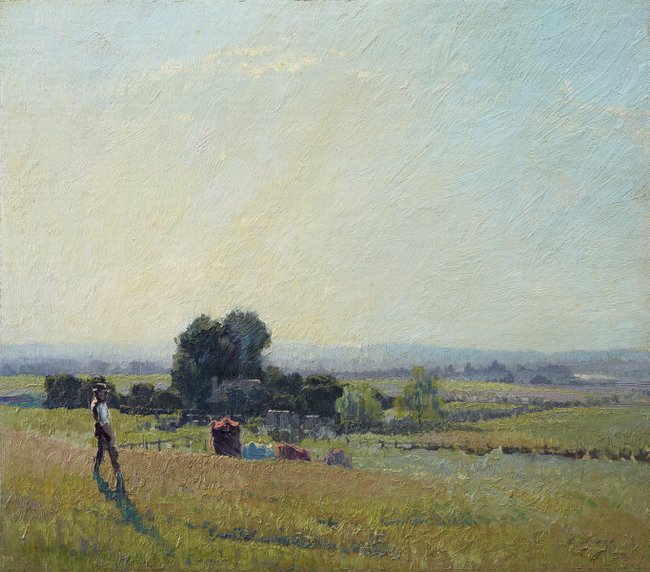
AGNSW collection Elioth Gruner Morning light 1916
The farmhouse and property depicted here is the exact same one shown in Spring frost, yet Morning light was painted three years prior and from a higher vantage point. Morning light was awarded the Wynne Prize for landscape painting in 1916 and created a serious buzz within the Sydney art world at the time. In 1918 Norman Lindsay praised the work, writing: ‘I think Gruner has realised the higher vision of landscape painting in his Morning light. He has painted the sensation of morning, a sensation not local or national, but universal’.
The Blue Mountains: a national icon
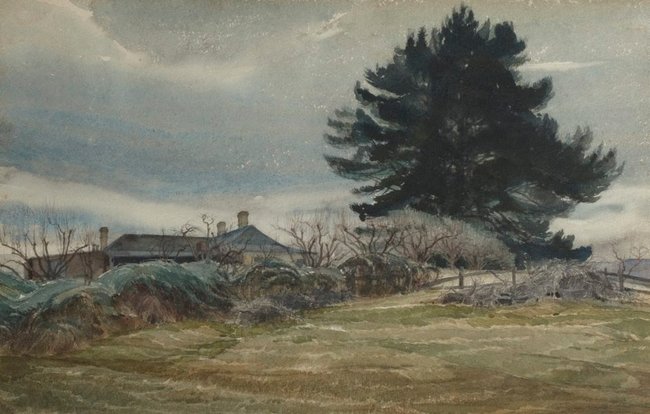
AGNSW collection Lorna Muir Nimmo Collitts Inn and the dark pines 1948
Lorna Nimmo was a pioneering figure in mid-century Australian art. She is renowned for becoming the first woman to win the Wynne Prize for landscape painting in 1941, and the first woman to be elected the president of the Australian Watercolour Institute in 1955. Nimmo trained under artists Douglas Dundas and Dorothy Thornhill at the East Sydney Technical School, and counted JMW Turner and John Ruskin’s ‘truth to nature’ dictum as major influences on her landscape practice.
Nimmo’s Collitts Inn and the dark pines depicts a historic homestead located in Hartley Vale on Gundungurra Country in the Blue Mountains, a place familiar to Nimmo who was raised in Hartley Vale. Nimmo’s realist landscapes often depict historic houses and rural landscapes within the Blue Mountains region.
